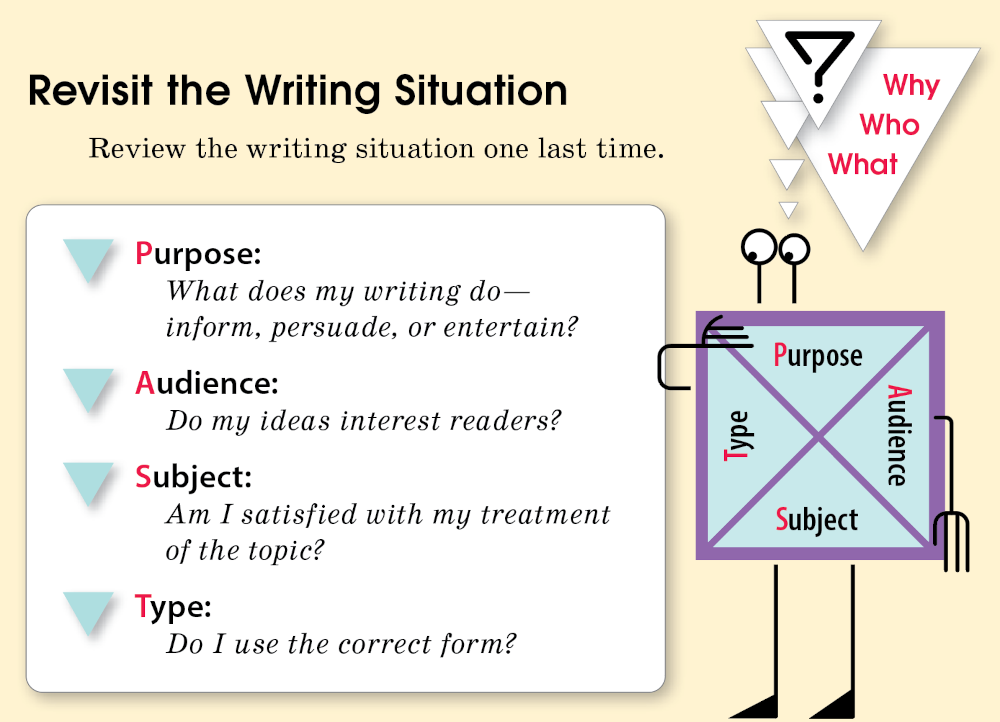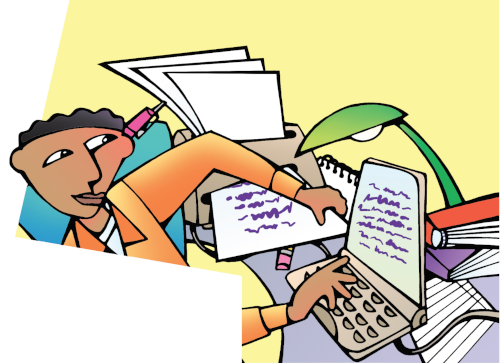WOC 065
Page 65

Publishing and Portfolios
Did you know that every time you send a text or email, you are publishing your writing? It’s true. The word “publish” just means “make your writing public.” When a message reaches the person you intended to read it, you’ve published.
So, publishing is driven by audience. Who do you want to read and respond to your writing? If you’ve written a story for a friend, providing the person a copy is publishing it. If you want complete strangers to read your story, you could publish it in your blog, or you could send it to an online magazine. And you’ll want to publish all your best writing by placing a copy in your portfolio.
Of course, before publishing, you make sure your writing is finished and error free. You’ll also design your writing for maximum effect. Learn how here.
What’s Ahead
WOC 066
Page 66
Quick Guide ■ Publishing
Publishing is the final step in the writing process. It makes your writing, revising, and editing worth the effort. You’re ready to publish once you . . .
- make all of the necessary changes and corrections,
- prepare a neat final copy of your work, and
- proofread this copy before sharing it.

Link to the Traits
Consider how well the writing addresses the traits.
Ideas ■
The writing gives clear information about the topic.
Organization ■
The writing includes a beginning, a middle, and an ending.
Voice ■
The voice connects with the reader and sounds knowledgeable about the topic.
Word Choice ■
The writing uses specific nouns and action verbs.
Sentence Fluency ■
The sentences flow smoothly.
Conventions ■
The writing is correct and clear.
WOC 067
Page 67
Presenting Your Writing

Design should serve ideas, making them clearer and more accessible to readers. Follow these tips.
Typography
- Use an easy-to-read font for the body and the headings.
- Use a title and headings. A title grabs the reader’s interest, and headings break the writing into smaller, more manageable units.
Spacing and Margins
- Double-space lines of text.
- Leave one-inch margins on all four sides of your paper.
- Indent the first line of every paragraph.
- Leave one space after every period.
- Avoid awkward breaks in text. Don’t leave the first line of a paragraph by itself at the bottom of a column (orphan), or the last line at the top (widow). Don’t leave a heading by itself at the bottom of a column (tombstone).
Graphic Devices
- Create bulleted or numbered lists to separate and highlight important points.
- Include a graphic (a table, a chart, or an illustration). Graphics make ideas easier to visualize.
- Size graphics appropriately. Balance graphics with text on the page. If the graphic must be large, place it on its own page.
Helpful Hint
These guidelines focus on academic writing—the essays, reports, and research papers that you turn in to your teachers. The design of your personal writing—stories, poems, blog posts, and so on—is entirely up to you. Browse popular magazines and the Internet for ideas.
WOC 068
Page 68
Effective Design in Action
Read the first two pages of a well-designed student report. Note how design makes the ideas more accessible.

WOC 069
Page 69

WOC 070
Page 70
"Whether applying for a job, pitching as a freelancer, or showcasing your work, an online portfolio with a biography and links to your work can be hugely valuable.”
—Sarah Marshall
Creating a Portfolio
A portfolio is a collection of your writing. You might create a showcase portfolio, a growth portfolio, or a personal portfolio.
Showcase Portfolio
A showcase portfolio presents your finest writing. You assemble essays, articles, stories, poems, and letters that represent your best work. At the end of a grading period, you submit them for evaluation.
Growth Portfolio
A growth portfolio shows a sequence of assignments, demonstrating how you are developing as a writer. Earlier work establishes a starting point, and later work shows growth in various skills, such as . . .
- writing beginnings and endings,
- using specific details and examples,
- arguing a point and answering objections, and
- varying sentence beginnings and lengths.
Personal Portfolio
A personal portfolio contains writing that means a lot to you. Many professional writers, artists, and musicians keep personal portfolios. You can arrange a personal portfolio according to different types of writing, different themes, and so on.
Helpful Hint
Whatever type of portfolio you create, keep an electronic version. That way, you can make changes and share work whenever you wish. You can also include graphics, videos, and sound.
WOC 071
Page 71
Assembling the Parts of a Portfolio

A showcase portfolio is the most common type in schools. Your portfolio may contain the parts listed below (but check with your teacher to make sure).
- A table of contents lists the parts of your portfolio.
- A reflective essay or letter discusses how you compiled your portfolio, how you feel about it, and what you’ve learned.
- A collection of finished pieces represents your best work.
- A cover sheet attached to each piece of writing discusses the reason for its selection. (See page 73.)
- A best “other” piece shows writing from another class.
- Rubrics or checklists chart the basic skills you have mastered as well as those you need to work on.
Points to Remember
When compiling a portfolio, remember to do the following:
- Make sure you understand the requirements for your portfolio.
- Keep track of all your work, including prewriting notes and various drafts. Your teacher may ask you to include all of the steps for a certain project.
- For storage, work with a pocket folder or computer file to avoid dog-eared or ripped pages.
- Keep on schedule. Work on your portfolio throughout the term. Don’t wait until the night before it’s due!
- Take pride in your work. Select writing that reflects well on you. Sometimes an imperfect piece can still tell about what you learned and how you are growing. Let your writing tell your story!
WOC 072
Page 72
Portfolio Pages
On these two pages, you will find an opening letter for a complete portfolio and a cover sheet for a particular piece of writing. Reviewing them will help you develop similar pages for your own portfolio.
Opening Letter for a Portfolio

WOC 073
Page 73
Cover Sheet for a Writing Selection

Points to Remember
A cover sheet should do one or more of the following things:
- Explain why you chose the piece of writing.
- Tell the story of the piece—how you wrote it.
- Identify the writing’s strong points and weak points.
- Reflect on its importance to you.
WOC 074
Page 74
Publishing Ideas
You can publish in many different ways. Some opportunities are immediate, such as sharing your writing with your classmates. Others are more adventurous and take some effort, such as entering a writing contest. Try a number of these ideas during the school year. Each new publishing experience will help you grow as a writer.

WOC 075
Page 75
"Publishing a book is like stuffing a note into a bottle and hurling it into the sea. . . . You never know who your readers might be.”
—Margaret Atwood
Sending Out Your Writing
The questions and answers listed below will help you submit your writing to publishers.
Q What types of writing can I submit?
A Newspapers are interested in articles, essays, and letters to the editor. Some magazines publish fiction, nonfiction, and poetry; others focus on nonfiction.
Q Where should I send my writing?
A Your chances of getting published are best close to home, so first consider local publications. If you’re interested in submitting something to a national publication, turn to Writer’s Market or Children’s Writer’s & Illustrator’s Market.
Helpful Hint
Writer’s Market comes in a print and an online subscription version. If your teacher or school library doesn’t have access to this resource, your city library will. The print version is also available in major bookstores.
Q How should I submit my work?
A Check the publication’s masthead for guidelines. The masthead is the small print on one of the opening pages identifying the publisher and editors. You should also visit its website for specific submissions guidelines. Most print publications expect you to include . . .
■ a brief cover letter identifying the title and form and
■ a neat copy of your work (formatted according to the guidelines) with your name and the title on each page.
Q What should I expect?
A Expect to wait a long time for a reply. Also understand that your writing might not be accepted, and you may get no response. Just keep writing and submitting.
WOC 076

Page 76
Publishing Online
The Internet offers many publishing opportunities, including online magazines and writing contests. The information that follows will help you submit your writing online.
Q What should I do first?
A Begin by checking with your teacher to see if your school has its own Web site where students can post their work. If not, suggest that one be started. Also ask your teachers about Web sites they know of that accept student submissions.
Q How should I begin my Web search?
A Use search engines to find places to publish. Bring up your favorite search engine and enter, “publish student writing.” Then check the results. Make sure that a publishing opportunity is free and the site is reputable before providing any material to publish.
Q How should I submit my work?
A Before you do anything, learn about the publishing guidelines for each site and share this information with your parents. Get their approval before submitting online. Then follow these guidelines:
■ Include a message explaining why you are contacting the site.
■ Send your work following the site’s requirements.
■ With a parent’s approval, provide the publisher with correct information for contacting you.
Q What should I expect?
A Within a week or so of your submission, you should receive a note from the publisher stating that your work has been received. It may take longer for the publisher to make a decision about your writing.
WOC 077
Page 77
Publishing in a Blog
One surefire way to publish online is to post your work on your own blog. Whether you have a stand-alone blog or a social networking page, you can share your work with friends online. Use these tips:
- Date your posts. Blog readers want to know when you posted your work. A date helps them find the most current posts but also track back to favorite posts.
- Create a strong title. Online readers are notorious skimmers. To get them to slow down and read, you need a title that grabs their attention.
- Post pieces with strong voice. Since a blog is a form of journal writing, pieces that let your voice shine through are best for blog posts.
- Add links. Connect your writing to other Web pages. For example, if you post something about whale song, link the words to a site that offers recorded audio clips of the sound.
- Post regularly. To keep readers returning to your blog, add new material on a regular basis.
Blog Post
